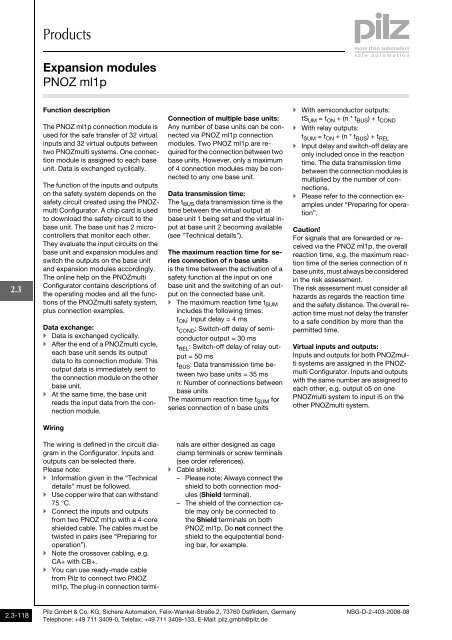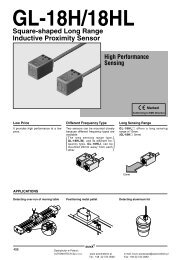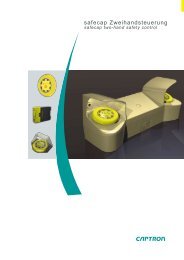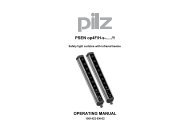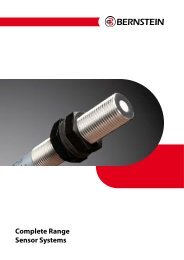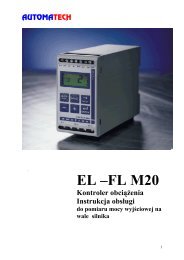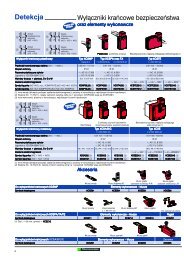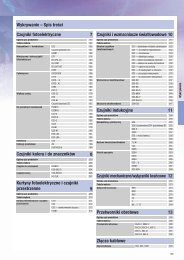Expansion modules - Automatech
Expansion modules - Automatech
Expansion modules - Automatech
Create successful ePaper yourself
Turn your PDF publications into a flip-book with our unique Google optimized e-Paper software.
Products<br />
<strong>Expansion</strong> <strong>modules</strong><br />
PNOZ ml1p<br />
2.3<br />
Function description<br />
The PNOZ ml1p connection module is<br />
used for the safe transfer of 32 virtual<br />
inputs and 32 virtual outputs between<br />
two PNOZmulti systems. One connection<br />
module is assigned to each base<br />
unit. Data is exchanged cyclically.<br />
The function of the inputs and outputs<br />
on the safety system depends on the<br />
safety circuit created using the PNOZmulti<br />
Configurator. A chip card is used<br />
to download the safety circuit to the<br />
base unit. The base unit has 2 microcontrollers<br />
that monitor each other.<br />
They evaluate the input circuits on the<br />
base unit and expansion <strong>modules</strong> and<br />
switch the outputs on the base unit<br />
and expansion <strong>modules</strong> accordingly.<br />
The online help on the PNOZmulti<br />
Configurator contains descriptions of<br />
the operating modes and all the functions<br />
of the PNOZmulti safety system,<br />
plus connection examples.<br />
Data exchange:<br />
Data is exchanged cyclically.<br />
After the end of a PNOZmulti cycle,<br />
each base unit sends its output<br />
data to its connection module. This<br />
output data is immediately sent to<br />
the connection module on the other<br />
base unit.<br />
At the same time, the base unit<br />
reads the input data from the connection<br />
module.<br />
Connection of multiple base units:<br />
Any number of base units can be connected<br />
via PNOZ ml1p connection<br />
<strong>modules</strong>. Two PNOZ mI1p are required<br />
for the connection between two<br />
base units. However, only a maximum<br />
of 4 connection <strong>modules</strong> may be connected<br />
to any one base unit.<br />
Data transmission time:<br />
The t BUS data transmission time is the<br />
time between the virtual output at<br />
base unit 1 being set and the virtual input<br />
at base unit 2 becoming available<br />
(see "Technical details").<br />
The maximum reaction time for series<br />
connection of n base units<br />
is the time between the activation of a<br />
safety function at the input on one<br />
base unit and the switching of an output<br />
on the connected base unit.<br />
The maximum reaction time t SUM<br />
includes the following times:<br />
t ON : Input delay = 4 ms<br />
t COND : Switch-off delay of semiconductor<br />
output = 30 ms<br />
t REL : Switch-off delay of relay output<br />
= 50 ms<br />
t BUS : Data transmission time between<br />
two base units = 35 ms<br />
n: Number of connections between<br />
base units<br />
The maximum reaction time t SUM for<br />
series connection of n base units<br />
With semiconductor outputs:<br />
tS UM = t ON + (n * t BUS ) + t COND<br />
With relay outputs:<br />
t SUM = t ON + (n * t BUS ) + t REL<br />
Input delay and switch-off delay are<br />
only included once in the reaction<br />
time. The data transmission time<br />
between the connection <strong>modules</strong> is<br />
multiplied by the number of connections.<br />
Please refer to the connection examples<br />
under “Preparing for operation”.<br />
Caution!<br />
For signals that are forwarded or received<br />
via the PNOZ ml1p, the overall<br />
reaction time, e.g. the maximum reaction<br />
time of the series connection of n<br />
base units, must always be considered<br />
in the risk assessment.<br />
The risk assessment must consider all<br />
hazards as regards the reaction time<br />
and the safety distance. The overall reaction<br />
time must not delay the transfer<br />
to a safe condition by more than the<br />
permitted time.<br />
Virtual inputs and outputs:<br />
Inputs and outputs for both PNOZmulti<br />
systems are assigned in the PNOZmulti<br />
Configurator. Inputs and outputs<br />
with the same number are assigned to<br />
each other, e.g. output o5 on one<br />
PNOZmulti system to input i5 on the<br />
other PNOZmulti system.<br />
Wiring<br />
The wiring is defined in the circuit diagram<br />
in the Configurator. Inputs and<br />
outputs can be selected there.<br />
Please note:<br />
Information given in the “Technical<br />
details” must be followed.<br />
Use copper wire that can withstand<br />
75 °C.<br />
Connect the inputs and outputs<br />
from two PNOZ ml1p with a 4-core<br />
shielded cable. The cables must be<br />
twisted in pairs (see “Preparing for<br />
operation”).<br />
Note the crossover cabling, e.g.<br />
CA+ with CB+.<br />
You can use ready-made cable<br />
from Pilz to connect two PNOZ<br />
ml1p. The plug-in connection terminals<br />
are either designed as cage<br />
clamp terminals or screw terminals<br />
(see order references).<br />
Cable shield:<br />
– Please note: Always connect the<br />
shield to both connection <strong>modules</strong><br />
(Shield terminal).<br />
– The shield of the connection cable<br />
may only be connected to<br />
the Shield terminals on both<br />
PNOZ ml1p. Do not connect the<br />
shield to the equipotential bonding<br />
bar, for example.<br />
2.3-118<br />
Pilz GmbH & Co. KG, Sichere Automation, Felix-Wankel-Straße 2, 73760 Ostfildern, Germany<br />
Telephone: +49 711 3409-0, Telefax: +49 711 3409-133, E-Mail: pilz.gmbh@pilz.de<br />
NSG-D-2-403-2008-08


